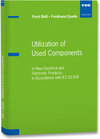
• Managers, who wish to be informed about the opportunities and challenges of reuse, and who plan to develop a recycling strategy.
• Participants in an organization’s entire supply chain, who wish to participate in the value-added chain of reuse to reduce costs, and decision makers from industrial or public administration, procurement, or purchasing – including quality and environmental engineers, customers, manufacturers or sales departments – who wish to be informed about the cost saving potential, risk avoidance, and legal aspects, as well as the background of dependability and reuse.
• Students of any discipline, who are interested in environmental and quality technology.
• Participants in an organization’s entire supply chain, who wish to participate in the value-added chain of reuse to reduce costs, and decision makers from industrial or public administration, procurement, or purchasing – including quality and environmental engineers, customers, manufacturers or sales departments – who wish to be informed about the cost saving potential, risk avoidance, and legal aspects, as well as the background of dependability and reuse.
• Students of any discipline, who are interested in environmental and quality technology.
Utilization of Used Components
in New Electrical and Electronic Products in Accordance with IEC 62309
von Fevzi Belli und Ferdinand QuellaSaving our environmental resources is a challenge and can only be achieved in the future through the reuse of components in new products. About 25 % of the existing electrical and electronic (E& E) components are suitable for reuse. In Europe, reuse is considered to be the best waste handling procedure. Therefore, reuse happens to be favored politically by a number of authorities at various levels, both national and European, which will increase its importance and relevance for industrial production. The present European Waste Framework Directive confirms this view. As a result, many non-European countries already have, or are preparing, similar directives. This will certainly lead to an increase in pressure to reuse components, supported by forthcoming international normative references, including legal and industrial standardization.
In accordance with the international standard IEC 62309 „Dependability of products containing reused parts – requirements for functionality and tests“ this book addresses technic, environmental, legal and economical questions. Each is clearly explained and easy to understand and is discussed in the relevant chapters. Details from the corresponding European directives are discussed (RoHS, WEEE, Waste Framework directive, Ecodesign directive, and many more).
The authors‘ objectives are • to define technical criteria and rules to support decision makers in determining whether to reuse, and where and how, in order to avoid negative environmental impact of industrial mass production; • to also include economic criteria for the support of decision makers that stress the importance of reuse in helping companies to cut costs and its impact nationwide on overall cost-effectiveness; • to explain the normative background and to discuss related major European legal regulations and directives; • to also discuss aspects that influence reuse, for example, the role of software in components and products planned for reuse.
In accordance with the international standard IEC 62309 „Dependability of products containing reused parts – requirements for functionality and tests“ this book addresses technic, environmental, legal and economical questions. Each is clearly explained and easy to understand and is discussed in the relevant chapters. Details from the corresponding European directives are discussed (RoHS, WEEE, Waste Framework directive, Ecodesign directive, and many more).
The authors‘ objectives are • to define technical criteria and rules to support decision makers in determining whether to reuse, and where and how, in order to avoid negative environmental impact of industrial mass production; • to also include economic criteria for the support of decision makers that stress the importance of reuse in helping companies to cut costs and its impact nationwide on overall cost-effectiveness; • to explain the normative background and to discuss related major European legal regulations and directives; • to also discuss aspects that influence reuse, for example, the role of software in components and products planned for reuse.









